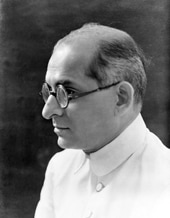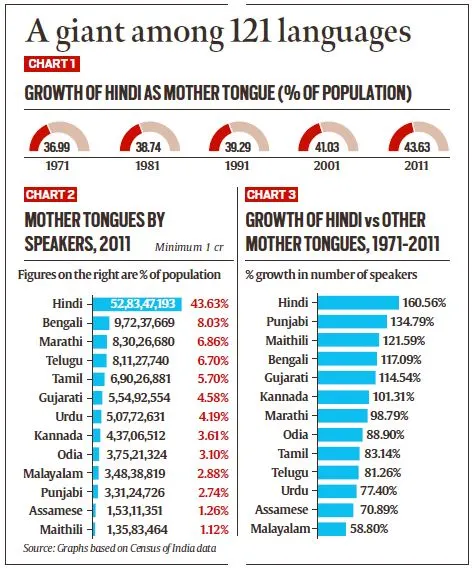
— It commemorates the Constituent Assembly of India making Hindi the official language of the Union government (while English was to hold the status of associate language for 15 years). What the Constitution said on India’s official language can be understood after knowing the Munshi-Ayyangar formula.
Key takeaways on Munshi-Ayyangar formula and Hindi Diwas
1. The Constituent Assembly chose Hindi as the official language of the country after extensive discussions over three days. (Note: Hindi was chosen not as the national language.)
2. Discussions were over what script should the Union adopt, what script should the numerals be in, and what should be the status of English. Hindustani (Hindi with more Urdu elements) and Sanskrit were among those proposed as official languages.
Some of the important voices in the debate on Hindi in the Constituent Assembly
RV Dhulekar: ‘Hindi should be national language’
Frank Anthony: ‘Don’t give up English’
Pandit Lakshmi Kanta Maitra: ‘Sanskrit should be national, official language’
Story continues below this ad
Qazi Syed Karimuddin: ‘In Hindustani, both Hindus and Muslims can express themselves’
TA Ramalingam Chettiar: ‘Hindi can’t be national language’
3. The Munshi-Ayyangar formula was adopted as a compromise solution. It was named after Drafting Committee members K M Munshi and N Gopalaswamy Ayyangar.
4. As part of the Munshi-Ayyangar formula, Article 343 of the Constitution as adopted in 1950 said:
(a) “The official language of the Union shall be Hindi in Devanagari script.”
Story continues below this ad
(b) “The form of numerals to be used for the official purposes of the Union shall be the international form of Indian numerals.”
(c) “…for a period of fifteen years from the commencement of this Constitution, the English language shall continue to be used for all the official purposes of the Union for which it was being used immediately before such commencement.”
5. When the 15-year period came to an end, protests broke out over the fear of imposition of Hindi in large parts of non-Hindi-speaking India, particularly in Tamil Nadu. The resistance resulted in the Centre passing the Official Languages Act. This Act stated that English would continue to be upheld as an official language along with Hindi.
JUST FYI: Who were Ayyangar and Munshi?
 Gopalaswamy Ayyangar (Wikimedia Commons)
Gopalaswamy Ayyangar (Wikimedia Commons)
6. A native of Tanjore, Narasimha Gopalaswami Ayyangar joined the Madras Civil Service in 1905 and served in several posts, including District Collector and Member of the Board of Revenue. In 1937, he was appointed the ‘Diwan’ or Prime Minister of J&K by Maharaja Hari Singh. He was elected to the Council of States in 1943 and served in the post until 1947. He was involved with various deliberations on Kashmir, and was the Indian representative for the Geneva convention in 1949. In 1950, he became Transport and Railways Minister, and served as the Defence Minister from 1952-1953.
Story continues below this ad
 Shri K.M. Munshi (Wikimedia Commons)
Shri K.M. Munshi (Wikimedia Commons)
7. Kanaiyalal Maneklal Munshi, was an Indian independence movement activist, politician, writer and educationist from Gujarat. Munshi also founded the Bhartiya Vidya Bhavan in 1938 with an aim to preserve Indian culture, education and art from a secular perspective. He participated in the Bardoli Satyagraha, Salt Satyagraha and the Quit India movement. After Independence he served as the Minister for Agriculture and Food till the year 1953 and as the Governor of Uttar Pradesh from 1953 to 1957. In 1954 he started a monthly journal called ‘Bhargava’ in Gujarati and Bhartiya Vidya Bhavan in 1938 with the vision to preserve Indian culture, education and art forms.
9. They both were part of the seven-member Drafting Committee – including B.R. Ambedkar (who was the Chairman of the drafting committee), Alladi Krishnaswami Ayyar, Mohammad Saadulla, B L Mitter, and D P Khaitan.
BTW:
10. The history of Hindi Diwas dates back to the early days of the Indian independence movement. In 1918, a group of Hindi scholars and activists formed the Hindi Sahitya Sammelan (Hindi Literary Conference) to promote the use of Hindi as a national language.
11. The Sammelan played a major role in the adoption of Hindi as the official language of India. After independence, the Constituent Assembly of India accepted Hindi, written in Devanagari script, as an official language on September 14, 1949. The first Hindi Diwas was celebrated in 1953.
Hindi Diwas: How widely is Hindi spoken in India?
Story continues below this ad
12. The 2011 linguistic census accounts for 121 mother tongues, including 22 languages listed in the 8th Schedule of the Constitution. Hindi is the most widely spoken, with 52.8 crore individuals, or 43.6% of the population, declaring it as their mother tongue. The next highest is Bengali, mother tongue for 9.7 crores (8%) — less than one-fifth of Hindi’s count.
13. In terms of the number of people who know Hindi, the count crosses more than half the country. Nearly 13.9 crore (over 11%) reported Hindi as their second language, which makes it either the mother tongue or second language for nearly 55% of the population.
 Source: Census of India data
Source: Census of India data
BEYOND THE WORD : World Hindi Day or Vishwa Hindi Diwas
World Hindi Day or Vishwa Hindi Diwas, is celebrated on January 10 every year to mark the importance and celebrate Hindi as a language.
Vishwa Hindi Diwas was started to mark the anniversary of the first time Hindi was spoken in the United Nations General Assembly (UNGA) in 1949. In the year 1975, the then Prime Minister Indira Gandhi inaugurated the first World Hindi Conference. Since then, conferences have been organised in different parts of the world.
Story continues below this ad
However, it was on January 10, 2006 when the World Hindi Day was celebrated for the first time. This decision was announced by the then Prime Minister of India, Manmohan Singh.
Point to ponder: What has been the history of the debate over Hindi’s status?
(Sources:How Constituent Assembly decided on Hindi as the official, and not national, language of India; Hindi Diwas, and the history of the debate over Hindi’s status,Explained: The languages India speaks, Why is January 10 celebrated as Vishwa Hindi Diwas?)
Subscribe to our UPSC newsletter and stay updated with the news cues from the past week.
Stay updated with the latest UPSC articles by joining our Telegram channel – IndianExpress UPSC Hub, and follow us on Instagram and X.
Story continues below this ad
For your answers, queries and suggestions write at manas.srivastava@indianexpress.com



 Gopalaswamy Ayyangar (Wikimedia Commons)
Gopalaswamy Ayyangar (Wikimedia Commons) Shri K.M. Munshi (Wikimedia Commons)
Shri K.M. Munshi (Wikimedia Commons) Source: Census of India data
Source: Census of India data





























